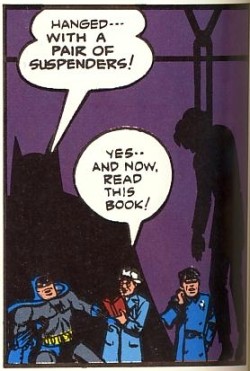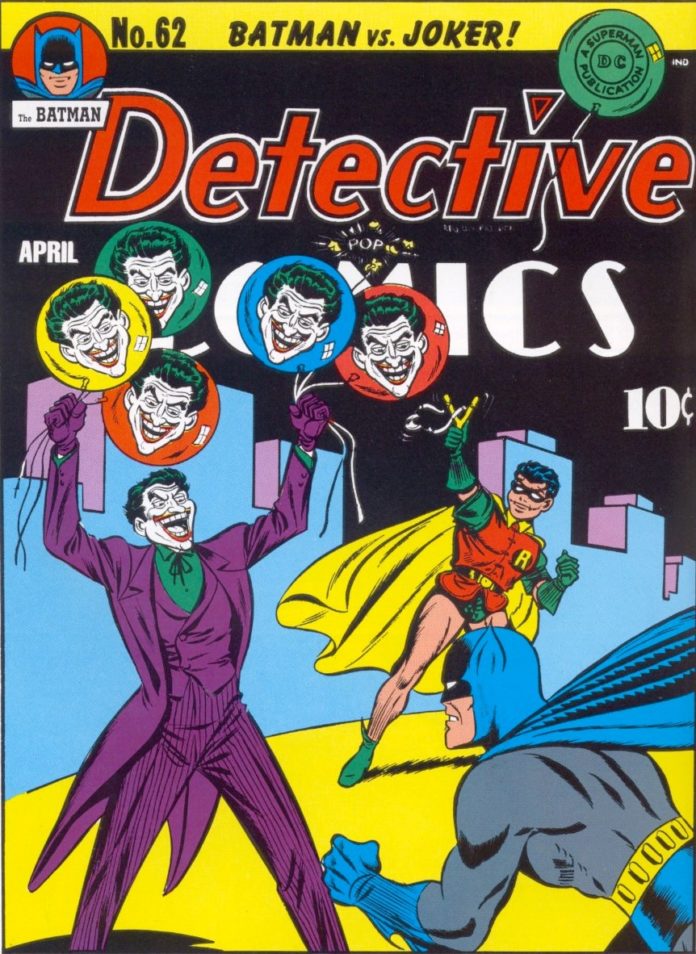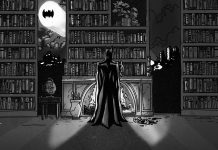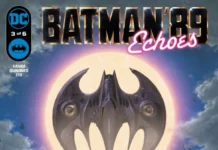PREVIOUS: A Joker’s Dozen, Part 10
One of the touchstones of The Joker’s interpretation in comics is the first dozen stories featuring the Joker that follow his introduction as a cold blooded killer and his transformation into a clever prankster that would bedevil Batman over the years without falling prey to the morality police. There are a dozen stories that make up this initial introduction, so 1 more part to go after this.
The Comic/Story: “Laugh, Town, Laugh” from DETECTIVE COMICS #62 (April 1942)
The Return: The Joker uses cellulose from a deck of cards to create an explosive and escape from prison.
The Plot: The Joker kills and terrorizes a group of comedians in hopes of putting together the clues to a treasure left in an odd will.
Body Count: Two (confirmed), one via strangulation, and one run over by a car.
Joker’s Running Body Count: 25 — plus potential car crash, train wreck, and bus crash victims.
Other Mayhem: The Joker’s explosive escape certainly at least injures guards, the Joker threatens and ties up a comedian and store clerk at knife point, sets up a deathtrap involving a metronome and vials of explosive, fights with Batman and Robin, The Joker and his gang use laughing gas to subdue two comedians and their guards, the Joker attempts to drown one comedian, The Joker and his gang fight with Batman and Robin again, The Joker sets up a deathtrap for Batman, killing of an endangered species, assault of a hotel desk clerk, and a final fight with Batman and Robin.
The Outthink: Batman escapes from The Joker’s deathtrap and tracks him down.
The Comeuppance: Batman captures The Joker and reveals that the pearls that the Joker thought were worthless were really quite valuable.

“Crimes were puzzles that Batman had to solve. And to create and solve the puzzles (Bill) Finger collected stray facts and intriguing fragments, gems of anecdotes and germs of ideas, and stored them away fro future use in prompting or embellishing some freshly inventive Batman plot.” – BATMAN: THE WORLD’S FINEST ARCHIVES, Vol. 1.
Reading that above description, it’s hard not to see Bill Finger’s fingerprints all over “Laugh, Town, Laugh”. An odd will, a cobbled together explosive from playing cards, new variations on old jokes, an interesting way to approach a boat, a tricky death trap with a nod to Hollywood, and a rare fact about pearls combine to form a fairly memorable Batman adventure.
Too bad, the same can’t be said for the cover. It’s a cover of historic importance, the Joker’s first cover appearance, but it’s very underwhelming. The Joker penned in by Batman and Robin and holding a bunch of balloons with his face on them. Robin popping one of the balloons with his slingshot in the only sense of dynamism about it. It’s story related, but seems like a last minute replacement. The splash page is much better as it shows the Joker fighting Batman and Robin while perched atop a gigantic joke book. And then the story jumps right into the plot.
We’re introduced to Happy Hanson, America’s “Foremost Comedian”, who dies cracking jokes on his death bed. But he’s left behind an odd will. For the reading of the will, five famous comedians are summoned, given five clues to a treasure, and told that there will be a contest and whoever tells the funniest joke at the end of the month will win all five clues and the fortune. Odd wills are a staple of pulp fiction and will feature prominently in several Batman stories, most famously in “The Joker’s Millions” from DETECTIVE COMICS #180 (February 1952) which was later turned into an animated episode on BTAS. It’s also worth noting that the five comedians pictured were apparently meant to represent actual comedians, although I can only identify three. Denny Jackson is obviously a stand in for Jack Benny. Buster Parks with his porkpie hat represents Buster Keaton. Claude S. Tilley stands for W.C. Fields. Unfortunately, I can’t identify “Freddy Banter” and “Ted Allenby”, although given the story it’s possible that they don’t represent anyone. It shows the passage of time that Batman was probably the least famous in 1942 and by now he’s the most recognizable personage in this story.
After that setup, we catch up with The Joker in prison, apparently harmlessly playing with cards. But, he’s scraping the cellulose off the cards for his own use. Soon, he packs the keyhole to his cell with dirt and attaches a bunk leg stuffed with cellulose to the other side of the lock.. When the lock won’t open, a torch is brought in to cut the cell open. As Bill Finger explains through the Joker, “cellulose, when heated, forms nitro-cellulose.. an explosive!” Soon the homemade pipebomb explodes in the guards face and the Joker is able to escape. Escape and notice the story in the paper about the will and his conceit that “the king of jesters” himself wasn’t invited to participate. So, he decides to invite himself to the context.
 And the plot is underway. Almost immediately The Batsignal flashes across the sky and Batman and Robin are summoned to the home of Freddie Banter only to find him hanged by a pair of his own suspenders. A very well drawn panel using the shadow of Banter to convey the horror of the scene while we see the reactions of Batman, Robin, and Gordon. Beyond Banter, they find a joke book with a Joker card inside with the answer to a classic joke changed. To “Ques. Why does a fireman wear red suspenders? Ans. To hold his pants up. Ans. To hang this fool up!” And the Joker’s card has a message announcing that he has the first clue and he’s entered the game. Batman as an “honorary member of the police” is recruited to help bring in the Joker. Before they can do much of anything, Ted Allenby is run over with the joke being “Ques. Why does a chicken cross the road? Ans. To get to the other side. Ans. But this poor cluck didn’t.” And we soon have the three famous comedians in Gordon’s office wanting protection. (It’s worth noting that Frank Miller employed a similar gambit in THE DARK KNIGHT RETURNS, and it’s certainly possible that this is a story he read while doing research.)
And the plot is underway. Almost immediately The Batsignal flashes across the sky and Batman and Robin are summoned to the home of Freddie Banter only to find him hanged by a pair of his own suspenders. A very well drawn panel using the shadow of Banter to convey the horror of the scene while we see the reactions of Batman, Robin, and Gordon. Beyond Banter, they find a joke book with a Joker card inside with the answer to a classic joke changed. To “Ques. Why does a fireman wear red suspenders? Ans. To hold his pants up. Ans. To hang this fool up!” And the Joker’s card has a message announcing that he has the first clue and he’s entered the game. Batman as an “honorary member of the police” is recruited to help bring in the Joker. Before they can do much of anything, Ted Allenby is run over with the joke being “Ques. Why does a chicken cross the road? Ans. To get to the other side. Ans. But this poor cluck didn’t.” And we soon have the three famous comedians in Gordon’s office wanting protection. (It’s worth noting that Frank Miller employed a similar gambit in THE DARK KNIGHT RETURNS, and it’s certainly possible that this is a story he read while doing research.)
The story speeds right along from there. Batman and Robin visit Denny Jackson’s house only to be informed by the Butler that Jackson has gone out to the music shop to buy a violin. Naturally, for a Jack Benny analog. Alas, the Butler is the generic sort, nothing like Benny’s Rochester, although given racial attitudes of the time it’s probably just as well. The Butler also describes the voice of a mysterious caller, who turns out to be the Joker as a “cold shivery voice”. Again, in direct contrast to his outward appearance. The Joker, of course, has gotten the jump on Denny, taken his clue, and left a trap involving a metronome and two vials of explosive when Batman and Robin arrive to save the day. A short fight ensues with the usual Golden Age shenanigans involving props, including The Joker getting knocked through a bass drum, but the Joker escapes when Batman and Robin simultaneously make a move to stop the metronome trap. And the revised joke this time is “Ques: Why is playing a piccolo like a prize fight? Ans: Because you can only get in one blow at a time. Ans: I’ve decided to put all the blows together and make a mighty blast!”
Instead of dragging it out, Bill Finger proves eager to resolve the Joker targeting comedians plot and move on to the next phase of the story. At this point, the police propose to guard Tilley and Batman and Robin go to guard Parks. Gotham’s police don’t prove up to it as they show no suspicion at all towards a balloon vender on stilts, who’s the Joker using his mastery of disguise again. The Joker uses his stilts to gain access to Tilley’s 2nd floor apartment and unleashes balloons containing laughing gas to render Tilley and the police helpless. Laughing gas attacks are an enduring motif of the Joker, although they’ve evolved to deadlier forms, and the idea was used famously in the pilot to the Adam West series, albeit by the Riddler. The Joker retrieves the 4th clue and leaves his 4th joke “Ques Why are certain comedians like balloons? Ans. Because they’re full of hot air. Ans You also are like balloons only you’re full of gas.”
At the same moment, Batman and Robin are under a similar gas attack from Joker’s henchmen. A broken window created by Batman provides enough fresh air so that Batman and Robin are able to pursue the henchmen and the kidnapped Parks to a pier. To avoid a lookout, Batman and Robin, use a set of inflatable “shoes” to walk on water and surprise the Joker. The inflatable shoes and approach look like something out of a newsreel, although I don’t know any way to legitimately verify the source of the idea. The idea works and they surprise the Joker and his gang while they’re busy attempting to drown Parks. (“Ques. What did the telephone operator say to the fisherman when he asked her for a date? Ans. Sorry, but this line is busy. Ans. And so is this one.” Well, four out of five decent variations isn’t bad.) However, while Robin is busy giving Parks artificial resuscitation, Batman is overcome by the Joker and his gang who take him back to the Joker’s hideout, where after assembling the clues and finding out there’s a checked package at a specific hotel, it’s confrontation and deathtrap time.
 The Joker offers the tied up Batman a choice of two doors, one leading to safety and the other to death. And, showing how far the artists have come in a few short years, there’s a terrifically framed shot of Batman tied up straddled by the grasshopper like legs of the Joker. The Joker wonders if he should just end Batman’s career then and there by unmasking him, but ultimately decides that he likes the battle of wits too much to resort to so simple a solution. An idea that remains a key character trait to these days and was featured in THE DARK KNIGHT. The Joker leaves while dropping a knife for Batman and promising him that there’s a clue in the room. Batman is confronted with the choice of a room containing a tiger and a room with spring loaded knives that will hurtle at whoever enters the door. And poison gas starts flooding the chamber to make Batman choose in a hurry. Batman is confident that he could kill the tiger with the knife, but wonders if that would be too simple, which tells you something about the confidence of the Golden Age Batman. Batman notices flies buzzing around the blades. Assessing the situation he chooses…. (Think about it for a moment and see if you can figure out Batman’s choice and reasoning.)
The Joker offers the tied up Batman a choice of two doors, one leading to safety and the other to death. And, showing how far the artists have come in a few short years, there’s a terrifically framed shot of Batman tied up straddled by the grasshopper like legs of the Joker. The Joker wonders if he should just end Batman’s career then and there by unmasking him, but ultimately decides that he likes the battle of wits too much to resort to so simple a solution. An idea that remains a key character trait to these days and was featured in THE DARK KNIGHT. The Joker leaves while dropping a knife for Batman and promising him that there’s a clue in the room. Batman is confronted with the choice of a room containing a tiger and a room with spring loaded knives that will hurtle at whoever enters the door. And poison gas starts flooding the chamber to make Batman choose in a hurry. Batman is confident that he could kill the tiger with the knife, but wonders if that would be too simple, which tells you something about the confidence of the Golden Age Batman. Batman notices flies buzzing around the blades. Assessing the situation he chooses…. (Think about it for a moment and see if you can figure out Batman’s choice and reasoning.)
OK, after that moment of suspense, Batman chooses the room with the blades. Which harmlessly break against his chest since they’re made of candy like prop knives in movies of the period. Which a smiling Batman explains to the reader as his brains overcome another deadly challenge. It’s a good thing too, since even if Batman had confronted the tiger, the room wasn’t airtight and the gas would have gotten Batman like it did the tiger. So it’s time to regroup with Robin and race to the hotel for a final confrontation with the Joker.
The Joker arrives in time to reclaim the checked package, which turns out to be a string of pearls. Pearls the Joker believes to be worthless because they’ve apparently lost their luster. After being thoroughly disappointed, the Joker is confronted by Batman and Robin who make short work of him. And then Batman reveals that the joke is on the Joker, because the pearls only need to come into contact with the human body in order to regain their luster. And the story ends with the Joker in the custody of the police, off to jail.
To me it seems like the creative team have settled in for the long haul by this point. The craft of writing and art had improved to the point of professionalism and experimentation. The Rogues Gallery has been firmly established as well as most of the supporting cast and story formulas. The stories had lightened up some from the grim, lurid beginnings, but the world was in the midst of WWII at the moment and the real world was grim enough. (I’d recommend the movie SULLIVAN’S TRAVELS for a well thought out case for the value of escapism in times of trouble.) Batman had evolved to the point which would last most of the next 30 years, a serious father figure, presumably to Robin and the audience, who was capable of a quip and a smile, and would show that brain power was often more important than muscle power. Not the most complex characterization, but a characterization that would hold up over time while more eccentric characters and situations were given a temporary spotlight around him. Much of the rest of the feature had been given a similar makeover, with the stuff that could become tedious or irresolvable excised, like Batman being wanted by the police.
The only thing left to really deal with was the Joker and the fact that he hadn’t paid for his crimes and should be looking at the death penalty. We’ll look at the solution to that in the next and final installment of this series. – Robert Reineke











